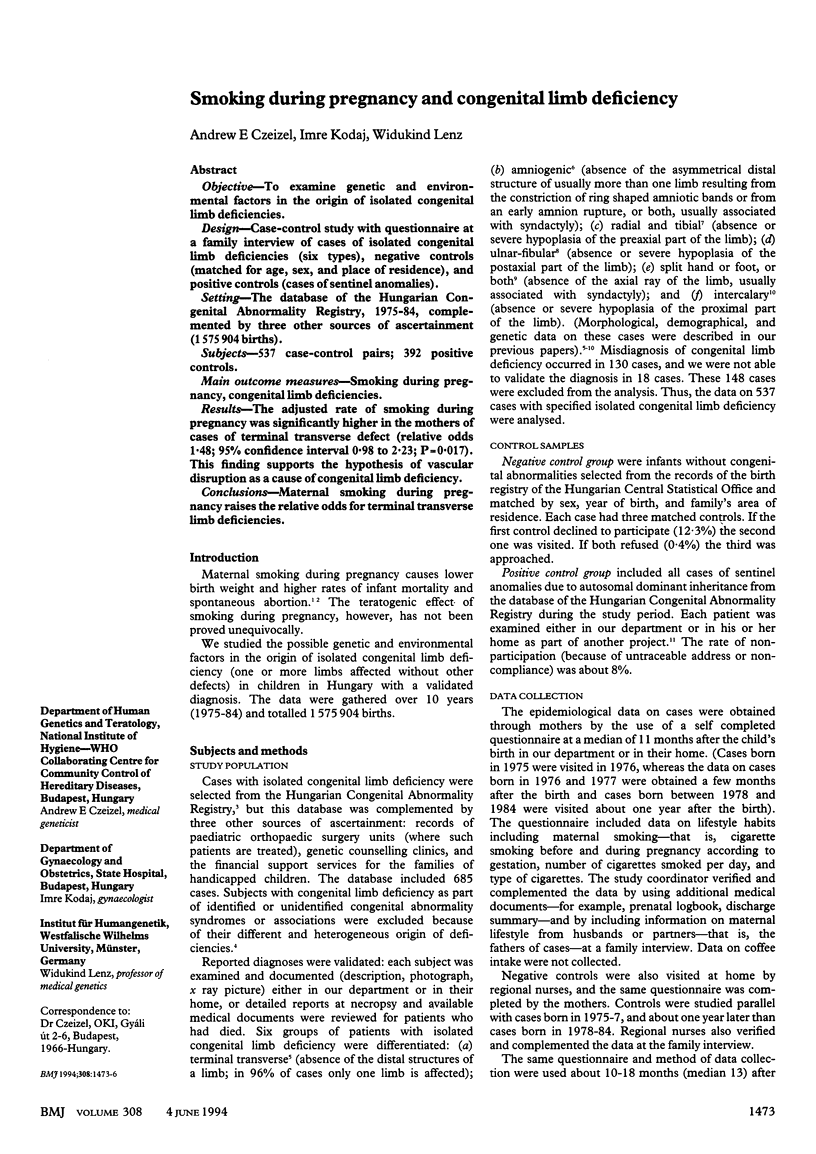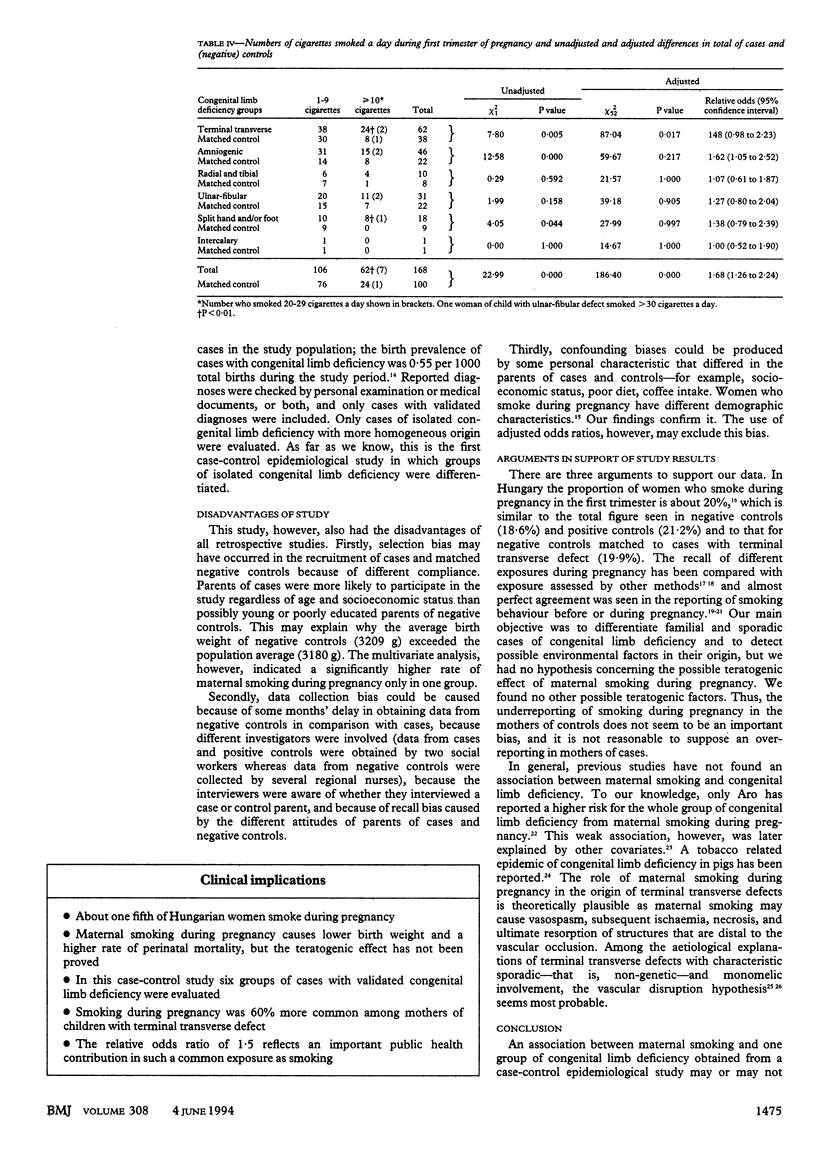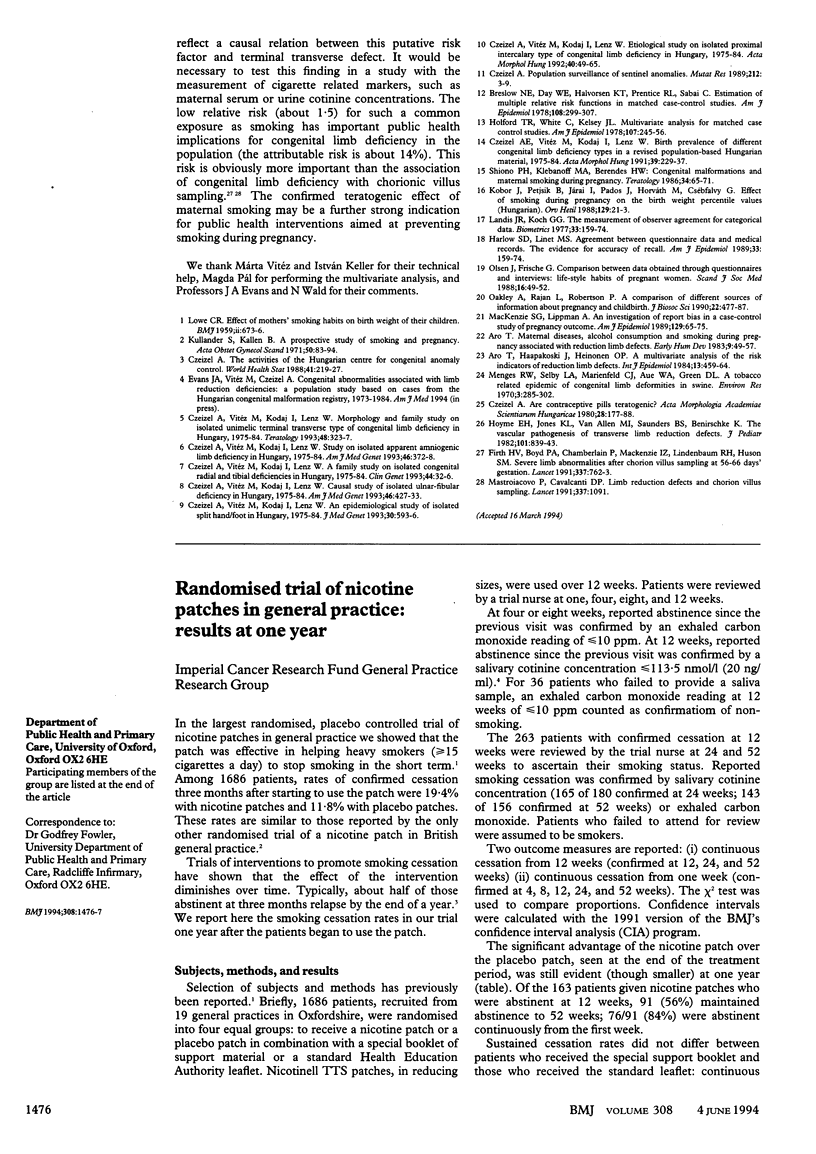Abstract
OBJECTIVE--To examine genetic and environmental factors in the origin of isolated congenital limb deficiencies. DESIGN--Case-control study with questionnaire at a family interview of cases of isolated congenital limb deficiencies (six types), negative controls (matched for age, sex, and place of residence), and positive controls (cases of sentinel anomalies). SETTING--The database of the Hungarian Congenital Abnormality Registry, 1975-84, complemented by three other sources of ascertainment (1,575,904 births). SUBJECTS--537 case-control pairs; 392 positive controls. MAIN OUTCOME MEASURES--Smoking during pregnancy, congenital limb deficiencies. RESULTS--The adjusted rate of smoking during pregnancy was significantly higher in the mothers of cases of terminal transverse defect (relative odds 1.48; 95% confidence interval 0.98 to 2.23; P = 0.017). This finding supports the hypothesis of vascular disruption as a cause of congenital limb deficiency. CONCLUSIONS--Maternal smoking during pregnancy raises the relative odds for terminal transverse limb deficiencies.
Full text
PDF



Selected References
These references are in PubMed. This may not be the complete list of references from this article.
- Aro T., Haapakoski J., Heinonen O. P. A multivariate analysis of the risk indicators of reduction limb defects. Int J Epidemiol. 1984 Dec;13(4):459–464. doi: 10.1093/ije/13.4.459. [DOI] [PubMed] [Google Scholar]
- Aro T. Maternal diseases, alcohol consumption and smoking during pregnancy associated with reduction limb defects. Early Hum Dev. 1983 Dec;9(1):49–57. doi: 10.1016/0378-3782(83)90101-9. [DOI] [PubMed] [Google Scholar]
- Breslow N. E., Day N. E., Halvorsen K. T., Prentice R. L., Sabai C. Estimation of multiple relative risk functions in matched case-control studies. Am J Epidemiol. 1978 Oct;108(4):299–307. doi: 10.1093/oxfordjournals.aje.a112623. [DOI] [PubMed] [Google Scholar]
- Bély M., Apáthy A., Pintér T., Ratkó J. Generalized secondary amyloidosis in rheumatoid arthritis. Acta Morphol Hung. 1992;40(1-4):49–69. [PubMed] [Google Scholar]
- Czeizel A. E., Vitéz M., Kodaj I., Lenz W. A morphological and family study on isolated terminal transverse type of congenital limb deficiency in Hungary, 1975-1984. Teratology. 1993 Oct;48(4):323–327. doi: 10.1002/tera.1420480405. [DOI] [PubMed] [Google Scholar]
- Czeizel A. E., Vitéz M., Kodaj I., Lenz W. An epidemiological study of isolated split hand/foot in Hungary, 1975-1984. J Med Genet. 1993 Jul;30(7):593–596. doi: 10.1136/jmg.30.7.593. [DOI] [PMC free article] [PubMed] [Google Scholar]
- Czeizel A. E., Vitéz M., Kodaj I., Lenz W. Causal study of isolated ulnar-fibular deficiency in Hungary, 1975-1984. Am J Med Genet. 1993 Jun 1;46(4):427–433. doi: 10.1002/ajmg.1320460416. [DOI] [PubMed] [Google Scholar]
- Czeizel A. E., Vitéz M., Kodaj I., Lenz W. Study of isolated apparent amniogenic limb deficiency in Hungary, 1975-1984. Am J Med Genet. 1993 Jun 1;46(4):372–378. doi: 10.1002/ajmg.1320460406. [DOI] [PubMed] [Google Scholar]
- Czeizel A. Are contraceptive pills teratogenic? Acta Morphol Acad Sci Hung. 1980;28(1-2):177–188. [PubMed] [Google Scholar]
- Czeizel A. Population surveillance of sentinel anomalies. Mutat Res. 1989 May;212(1):3–9. doi: 10.1016/0027-5107(89)90017-1. [DOI] [PubMed] [Google Scholar]
- Czeizel A. The activities of the Hungarian Centre for Congenital Anomaly Control. World Health Stat Q. 1988;41(3-4):219–227. [PubMed] [Google Scholar]
- Czeizel A., Vitéz M., Kodaj I., Lenz W. Birth prevalence of different congenital limb deficiency types in a revised, population based Hungarian material, 1975-1984. Acta Morphol Hung. 1991;39(3):229–237. [PubMed] [Google Scholar]
- Firth H. V., Boyd P. A., Chamberlain P., MacKenzie I. Z., Lindenbaum R. H., Huson S. M. Severe limb abnormalities after chorion villus sampling at 56-66 days' gestation. Lancet. 1991 Mar 30;337(8744):762–763. doi: 10.1016/0140-6736(91)91374-4. [DOI] [PubMed] [Google Scholar]
- Holford T. R., White C., Kelsey J. L. Multivariate analysis for matched case-control studies. Am J Epidemiol. 1978 Mar;107(3):245–256. doi: 10.1093/oxfordjournals.aje.a112531. [DOI] [PubMed] [Google Scholar]
- Kóbor J., Pejtsik B., Járai I., Pados E., Horváth M., Csébfalvi G. Terhesség alatti dohányzás hatása a születési súlypercentilis értékek alakulására. Orv Hetil. 1988 Jan 3;129(1):21–23. [PubMed] [Google Scholar]
- Landis J. R., Koch G. G. The measurement of observer agreement for categorical data. Biometrics. 1977 Mar;33(1):159–174. [PubMed] [Google Scholar]
- Limb-reduction defects and chorion villus sampling. Lancet. 1991 May 4;337(8749):1091–1092. doi: 10.1016/0140-6736(91)91735-D. [DOI] [PubMed] [Google Scholar]
- Mackenzie S. G., Lippman A. An investigation of report bias in a case-control study of pregnancy outcome. Am J Epidemiol. 1989 Jan;129(1):65–75. doi: 10.1093/oxfordjournals.aje.a115125. [DOI] [PubMed] [Google Scholar]
- Menges R. W., Selby L. A., Marienfeld C. J., Aue W. A., Greer D. L. A tobacco related epidemic of congenital limb deformities in swine. Environ Res. 1970 Nov;3(4):285–302. doi: 10.1016/0013-9351(70)90022-8. [DOI] [PubMed] [Google Scholar]
- Oakley A., Rajan L., Robertson P. A comparison of different sources of information about pregnancy and childbirth. J Biosoc Sci. 1990 Oct;22(4):477–487. doi: 10.1017/s0021932000018885. [DOI] [PubMed] [Google Scholar]
- Olsen J., Frische G. Comparison between data obtained through questionnaires and interviews: life-style habits of pregnant women. Scand J Soc Med. 1988;16(1):49–52. doi: 10.1177/140349488801600108. [DOI] [PubMed] [Google Scholar]
- Shiono P. H., Klebanoff M. A., Berendes H. W. Congenital malformations and maternal smoking during pregnancy. Teratology. 1986 Aug;34(1):65–71. doi: 10.1002/tera.1420340109. [DOI] [PubMed] [Google Scholar]


